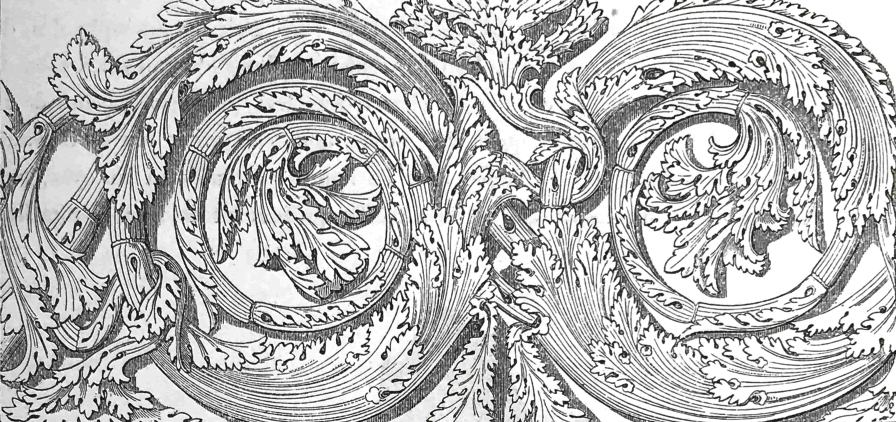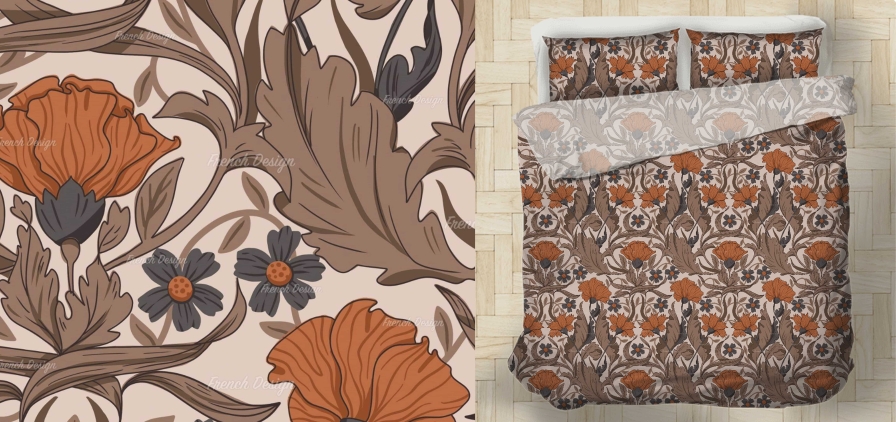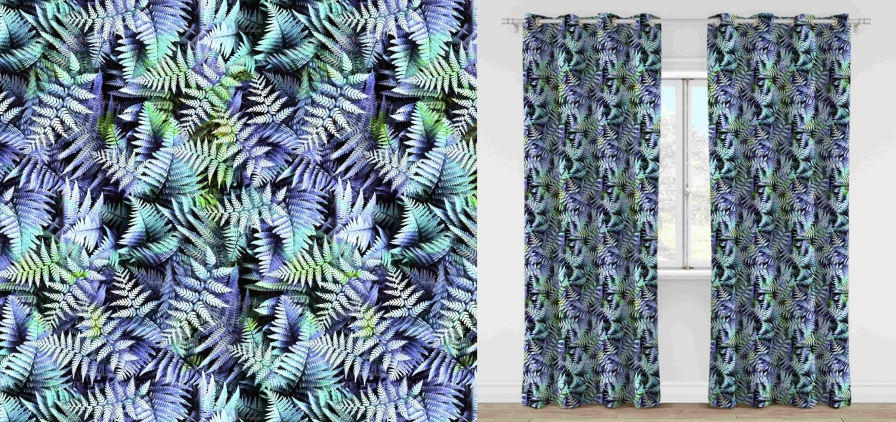
Vegetal seamless patterns in the textile world
Whether purely decorative or symbolic, vegetal seamless patterns abound in the history of art and design. They span centuries and cultures, reflecting the importance of nature in the eyes of humanity. Let's trace the history of botanically inspired decorations since Antiquity, before taking a closer look at vegetal surface patterns applied to textiles.
History and Origins of Vegetal surface patterns
According to anthropologists, our Paleolithic ancestors already had a "consciousness of beauty" in the Upper Paleolithic, but they likely preferred to devote their creative talent to representatives of the animal kingdom rather than plant species. With a few rare exceptions, plants are absent from works of cave art.
The first remains that truly attest to humans' fascination with the vegetal world date back to Antiquity. In Egypt, papyrus, lotus, and palm tree surface patterns already adorned temples and sarcophagi. In Greco-Roman art, vegetal surface patterns appeared on frescoes, friezes, mosaics, and ceramics. The Romans enjoyed making garlands of flowers and leaves, and cultivated several types of plants (especially roses) for purely ornamental purposes. Alongside flowers and fruit, the acanthus leaf was an emblematic decorative element of the Corinthian style, later adopted in classical architecture.
In the Middle Ages, art was closely linked to religion and Christian dogma. Created by God, plants and flowers carried the messages of the Church, but remained relatively secondary in iconography. Stylized, symmetrical, and essentially decorative, vegetal seamless patterns were among the favored ornaments for manuscript illuminations, stained-glass windows, and tapestries.
Influenced by the revival of ancient culture and the Great Discoveries, European artists became interested in botany from the Renaissance onward. They strived to reproduce plants as faithfully as possible. Naturalistic representations took off, and increasingly complex vegetal surface patterns appeared in goldwork, textiles, and architecture.

Vegetal seamless patterns in Art Nouveau
At the dawn of the 20th century, the world was shaken by the rapid development of industrialization, a phenomenon as exciting as it was worrying. In response, many European artists and intellectuals rejected these major advances, advocated a return to craftsmanship, and were inspired by their desire to celebrate the beauty of nature.
This creative impulse pushed the world of Fine Arts to draw closer to that of applied arts, thus introducing the notion of "design": the desire to integrate art into all creations, including everyday objects. The transposition of a sublime nature into art marked a turning point in the use of plant-inspired seamless patterns. With this in mind, the British Arts and Crafts movement, initiated by designer William Morris, emphasized repeated floral or vegetal-inspired designs in soft colors on wallpaper or fabric.
Following on from this trend, Art Nouveau emerged, characterized by the systematic representation of organic forms and natural curves in art and architecture. A "total art" encompassing all areas of decorative arts, this movement was spearheaded by iconic creators such as Antoni Gaudi, Victor Horta, Émile Gallé, and Alphonse Mucha. The Art Nouveau style was expressed in painting, sculpture, and illustration, leaving behind a body of work that was instantly recognizable. Compositions as bold as they were elegant invaded illustrations and pieces of furniture, paying homage to noble plants and wild grasses alike. Because Art Nouveau is also distinguished by the diversity of its vegetal surface patterns, from the umbel to the rose, the iris or the poppy, from the ginkgo leaf to the poppy and from the thistle to the exotic vine... This profusion of flowers, foliage and intertwined stems, these delicately crafted facades and ironwork, but also these vases and lamps decorated with delicate floral designs thus constitute a precious heritage which still inspires artists.
 Vegetal surface pattern "WILLY" created by Pauline MARY Illustration, textile designer at French Design by Textile Addict
Vegetal surface pattern "WILLY" created by Pauline MARY Illustration, textile designer at French Design by Textile Addict
Some examples of the use of vegetal surface pattern in textile design
The tree: a timeless vegetal seamless pattern in textile decoration
Symbolizing life, wisdom, and family ties, the tree is a classic textile surface pattern. It can be found in various forms, from the most minimalist to the most detailed. It is often used in large allover prints on upholstery fabrics, curtains, and wallpapers evoking the forest, to create a natural and comforting atmosphere.
The fir tree: an emblematic vegetal surface pattern in fabrics and decoration
Obviously associated with the holiday season, the fir tree is also an emblematic surface pattern of Scandinavian culture. In this Nordic spirit, designers love to integrate its graphic and slender silhouette into simple and contemporary compositions, illuminated with bright colors.
The leaf: an essential vegetal surface pattern in textile design
The leaf is one of the most commonly represented plant elements in textile design, regardless of trends. It comes in an infinite number of styles, from lush, ultra-detailed tropical prints to stylized foliage suggested by simple geometric shapes. Fashion uses it for the fresh look it instantly brings to a room, and interior design likes to play on its subtlety to bring dynamism and lightness to a composition.

The palm tree: a vegetal seamless pattern in exotic and natural colors
Exotic, slender, and majestic, as elegant as it is whimsical, this powerful vegetal design invites travel and relaxation, evoking faraway destinations. Printed curtains, cushions, and linens give it pride of place to enliven interiors with a bohemian feel. In clothing, palm tree designs are found exclusively in summer, on light and flowing outfits, instantly infusing a sunny, tropical charm to flowing dresses and lightweight tops.
The cactus: a minimalist and modern vegetal design
Although its different varieties cover a wide range of shapes and sizes, this plant remains naturally simple and geometric. This is undoubtedly why the cactus seamless pattern is so popular in current textile design. Its generally minimalist aesthetic often makes it the key element of monochrome or very colorful and playful fabric prints. Inseparable from the atmosphere that permeates desert landscapes, it brings an exotic and original touch to interior design. Its offbeat side is regularly highlighted in trends and its simplicity combines perfectly with a collection of casual clothing or accessories.
FAQ: Everything you need to know about vegetal textile patterns
How to incorporate a vegetal surface pattern into your interior design?
Incorporating a vegetal textile pattern into your interior design requires more than just adding printed textiles, such as cushions or a duvet cover. To create true harmony, it's essential to enrich the look with natural elements. Opt for raw materials like linen, stone, or wood, which evoke the authenticity of nature. Wallpaper in soft shades, such as white, beige, or light gray, can also enhance this soothing atmosphere. Finally, don't forget to incorporate authentic plant-based touches by arranging vegetal and flowers, which will bring freshness, nature, and vitality to your interior design.
What fabrics are best suited to a vegetal surface pattern?
Choosing the ideal fabric for a floral surface pattern depends on several factors: the type of plant or flower depicted, the style of the surface pattern, and how it complements the rest of your interior design, if it's a home textile rather than a piece of clothing.
Generally speaking, the best fabric choices for a floral seamless pattern are linen, cotton, and silk.
Why are floral surface patterns so popular in interior design?
As we mentioned in our article on the history of textile patterns, floral surface patterns are among the most popular textile designs, particularly in interior design. Their success can be explained by several reasons:
First, floral textile patterns bring an emotional dimension to a space. Each flower evokes a particular mood: red flowers symbolize love, yellow flowers exude joyful energy, while pink flowers inspire softness and tenderness. Depending on the atmosphere you want to create, you can choose different types of flowers to enhance your interior design with matching floral textile patterns.
Floral surface patterns are also a simple and effective way to add color to a room. For example, cushions adorned with orange tulips or a white duvet cover dotted with rose seamless patterns add a touch of cheerfulness and vibrancy. They brighten up a home while remaining elegant and trendy, creating a decor that's both refined and natural.
How to combine a floral surface pattern cushion with a plain sofa?
|
Sofa color |
Floral surface patterns and suitable fabrics |
Ideal colors |
Decorating tips and ambiance |
|---|---|---|---|
|
White / Beige |
Linear vegetal surface pattern on linen or cotton fabric |
Black, leaf green, touches of colorful flowers |
Ideal for a A warm and natural ambiance, perfect with linen curtains. |
|
Light Gray / Dark Gray |
Cushions with Stylized Floral Surface Patterns |
White, Botanical Blue, Powder Pink |
Provides an elegant and modern effect, can be combined with a panoramic design on a wall. |
|
Navy Blue |
Printed Canvas Cushion, Tropical Floral Seamless Pattern |
White, Gold, Mustard Yellow, Foliage |
Decorative Touch Sophisticated, ideal for contemporary spaces. |
|
Fir Green / Khaki |
Natural look, foliage and vegetal surface patterns |
Beige, terracotta, black |
Creates a natural, green ambiance, to match with wooden elements. |
Where can I find unique, high-quality plant motifs for my textile creations?
Discover our exclusive collections of floral and plant-based textile patterns, designed to enhance your textile creations with elegance and originality.




















